
This post may contain affiliate links which means I may receive a commission for purchases made through links. Learn more on my Private Policy page.
Sanding Tips: Using an Old Blade as a Detail Sander
Sanding is a crucial step in any woodworking project. It’s the process of smoothing down rough surfaces and preparing them for finishing. Sanding is not just about applying a sandpaper to the surface for rubbing it. There are tricks and tips that can simplify the sanding process and achieve the desired finish. When sanding big broad areas, using a random orbit sander seems to be a pretty easy process. But when it comes to getting into corners or small areas, it’s not that easy. This is where a detail sander comes into play. In this article, we will discuss how to make a DIY detail sander at home using an old blade.
Using a Detail Sander
Detail sanders are small sanders with a triangular pad that you can use to sand small spaces that are not easily accessible with a regular sander. These small sanders are a must-have for anyone who works on detailed woodwork. Detail sanding pads come in various shapes and sizes, and they do make a difference in the finished products’ look and feel.
However, detail sanders can be challenging to work with, especially when you need to sand tight corners or small spaces. And, buying a new detail sander can be costly. A solution to this problem is making your detail sander using an old blade.
Making a DIY Detail Sander with an Old Blade
Turning an old blade into a detail sander is easy and quick. It’s a simple DIY project that requires minimal time and equipment. Below are the steps to make your DIY detail sander at home.
Step 1: Prepare the Equipment
To create a DIY detail sander, you will need an old blade, a grinder or a hand file, double stick tape, scissors, a razor knife, sandpaper, and safety gear such as gloves and goggles.
Step 2: Remove the Teeth
The first step in creating a DIY detail sander from an old blade is removing the teeth. Using a grinder or a hand file, flatten the blade and remove the teeth. The teeth can cause sharp edges that might puncture through the sandpaper.
Step 3: Flatten the Blade
After removing the teeth, flatten the blade entirely across the front. Use the grinder or hand file to grind the top of the blade flat. Ensure that the blade is smooth and flat to create a proper sanding surface.
Step 4: Remove the Burrs
It’s essential to remove the burrs on the blade after grinding. Burrs are the rough edges remaining after grinding the blade. Use the grinder gently and press the blade against the side of the wheel to remove any burrs.
Step 5: Attach the Sandpaper
To attach the sandpaper to the blade, use double stick tape. Place the double stick tape on the blade and trim it to size using scissors and a razor knife. Peel off the paper from the double stick tape and attach the sandpaper.
Step 6: Use the DIY Detail Sander
After attaching the sandpaper, your DIY detail sander is now ready for use. Sand corners or tight spaces with ease, without the need to buy expensive detail sanders. You can switch between grits of sandpaper on the same blade, making it a versatile tool.
Advantages of Using an Old Blade as a Detail Sander
There are many benefits to using an old blade as a DIY detail sander, some of which include:
1. Cost-Effective: Detail sanders can be expensive, and if you only require them for specific projects, it’s uneconomical to buy a new one. Using an old blade makes it cost-effective as you can use something you already have.
2. Customizable: Depending on the size of your old blade, you can shape it to the size and shape you need. If you require the detail sander to be narrow, you can file it down to that size.
3. Versatile: A DIY detail sander can be customized to fit a range of different sandpaper grits. This means you can switch between rough and fine sandpaper for your project, without the need for two separate sanders.
4. Easier to Replace Sandpaper: Replacing sandpaper on a detail sander is much easier with a DIY sander. Remove the old sandpaper, cut a new piece and apply it to the adhesive tape. It’s that simple.
Conclusion
Creating your DIY detail sander using an old blade can save time and money. It’s an easy DIY project that doesn’t require special skills or equipment. The result is a versatile tool that’s cost-effective, customizable, and easier to replace sandpaper. Using a DIY detail sander helps you achieve a remarkable finish on your woodworking projects.
This post may contain affiliate links which means I may receive a commission for purchases made through links. Learn more on my Private Policy page.







Works really MyBest.Tools well, and fits hand perfectly.
Another great tip. Thanks
Excellent video, great idea. Never knew about it, thank you for thr tip
Thanks. Great tip.
glue a velcro loop patch on instead of double stick tape and now you can cut those used sandpaper pieces in this set up too.
Love your stand up comedy…"Now I just have to figure out what to do with those little sandpaper pieces" 🙂 Thanks for sharing Jim!
Those multitools sure are loud, but they can be the only tool for certain jobs. Thanks for another helpful video.
Great idea!
Felicidades, es un buen ejemplo. 354 sentadillas son unos YOURGIRLS.Uno muchas y un buen ejercicio. Se deja ver que hay muy buenos resultados 😍👍 Saludos desde la Cd.. de world 🌹😉💖 los mortalesm abian apreciado tan hermosa mujer.k